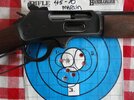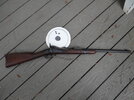unspellable
Member
Given a vintage 45-70 trapdoor, what factory loads would you use in it. Some of the modern 45-70 factory loads strike me as a bit spiffy for the old gal.
Remington used to have a 405 load but probably not now, I have a new rule for trapdoors black powder only not even 5744. It's so easy to load and and much cheaper then paying $50+ for a box off factory.
Edited ^^^please post the amount and what kind powder caused that along with what bullet was fired, a blanket statement like that is misleading.


Bingo! Give the man a cigar!that load is well with in a safe load for a 45-70 trapdoor in good condition.
That has been disproved enough it is amazing folks still repeat it. Competitor routinely load MORE than 70 grains in modern cases.Some historic info for those thinking of loading black powder cartridges-
Review and know about "balloon head" cases. The originals for many black powder guns were made that way and that's why they can accept a full charge of black powder while a modern case with a solid web cannot
Technically, you "could" load a little more powder in a balloon head case, but not enough difference to make a difference. I agree, for plinking, killing targets, gongs, or pop cans, milk jugs and water bottles, the carbine loads are fine. Or for deer hunting. But, one would still want some powder compression, and to take up the empty space with wads.You can 100% load more powder into balloon head cases, the 55 grain carbine load is more power then many shoots need.
The Armory used three methods to deal with the Carbine load.…
I have heard, and perhaps I have this completely wrong, that sometimes in the carbine loads a cardboard tube was inserted in the case, and the powder contained in that. ??
